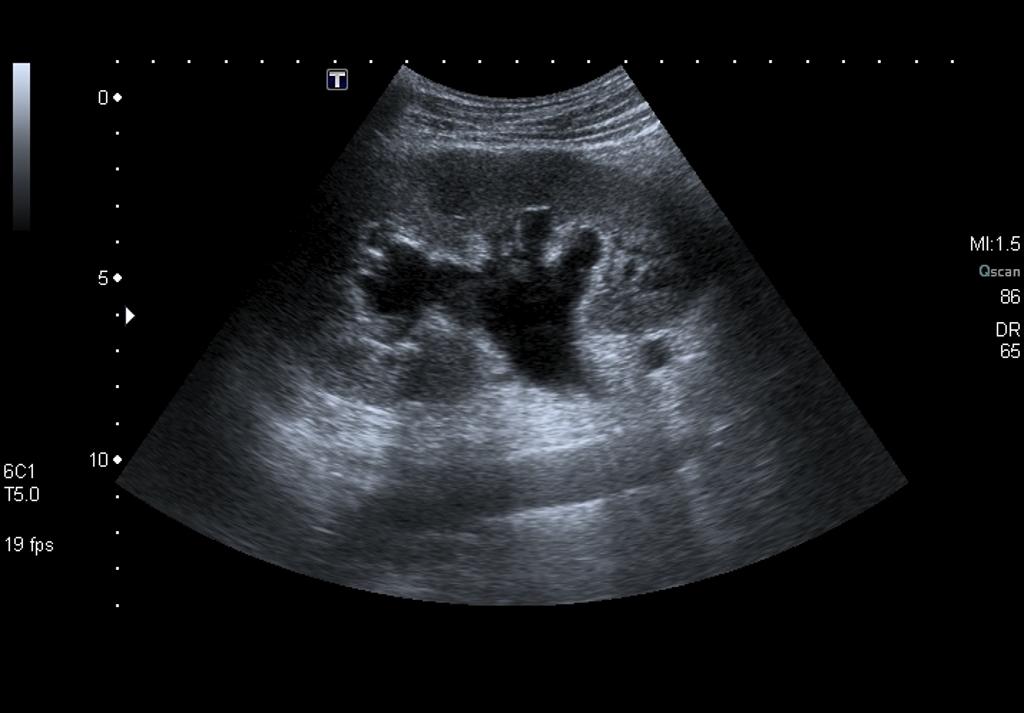Hydronephrosis diagnostic study of choice
Jump to navigation
Jump to search
|
Hydronephrosis Microchapters |
|
Diagnosis |
|---|
|
Treatment |
|
Case Studies |
|
Hydronephrosis diagnostic study of choice On the Web |
|
American Roentgen Ray Society Images of Hydronephrosis diagnostic study of choice |
|
Risk calculators and risk factors for Hydronephrosis diagnostic study of choice |
Editor-In-Chief: C. Michael Gibson, M.S., M.D. [1]; Associate Editor(s)-in-Chief: Vamsikrishna Gunnam M.B.B.S [2]
Overview
Renal ultrasonography is the diagnostic study of choice for the diagnosis of hydronephrosis. Early diagnosis of hydronephrosis is important because most of the cases can be reversed if treated promptly which can prevent irreversible renal injury.
Diagnostic Study of Choice
Study of choice
- Renal ultrasonography is the diagnostic study of choice for the diagnosis of hydronephrosis.[1]
- The following results of ultrasonography is confirmatory of hydronephrosis:[2][3][4][5]
- Hypoechoic fluid displaces the echogenic sinus fat
- Anechoic black area
- Can detect dilation of the proximal renal pelvis of the kidney due to obstruction
- Can detect dilation of the renal pelvis and calyces of the kidney due to obstruction
- Can detect thinning of the renal cortex
The comparison of diagnostic studies for hydronephrosis
| Test | Positive predictive value | Negative predictive value | Sensitivity |
|---|---|---|---|
| Ultrasonography | 0.77 | 0.71 | 98%[6] |

References
- ↑ Ellenbogen PH, Scheible FW, Talner LB, Leopold GR (April 1978). "Sensitivity of gray scale ultrasound in detecting urinary tract obstruction". AJR Am J Roentgenol. 130 (4): 731–3. doi:10.2214/ajr.130.4.731. PMID 416685.
- ↑ Ellenbogen PH, Scheible FW, Talner LB, Leopold GR (April 1978). "Sensitivity of gray scale ultrasound in detecting urinary tract obstruction". AJR Am J Roentgenol. 130 (4): 731–3. doi:10.2214/ajr.130.4.731. PMID 416685.
- ↑ Kuuliala IK, Niemi LK, Ala-Opas MY (1988). "Ultrasonography for diagnosis of obstructing ureteral calculus". Scand. J. Urol. Nephrol. 22 (4): 275–7. PMID 3070720.
- ↑ Talner LB, Scheible W, Ellenbogen PH, Beck CH, Gosink BB (1981). "How accurate is ultrasonography in detecting hydronephrosis in azotemic patients?". Urol Radiol. 3 (1): 1–6. PMID 7281377.
- ↑ Leo MM, Langlois BK, Pare JR, Mitchell P, Linden J, Nelson KP, Amanti C, Carmody KA (June 2017). "Ultrasound vs. Computed Tomography for Severity of Hydronephrosis and Its Importance in Renal Colic". West J Emerg Med. 18 (4): 559–568. doi:10.5811/westjem.2017.04.33119. PMC 5468059. PMID 28611874.
- ↑ Kuuliala IK, Niemi LK, Ala-Opas MY (1988). "Ultrasonography for diagnosis of obstructing ureteral calculus". Scand. J. Urol. Nephrol. 22 (4): 275–7. PMID 3070720.